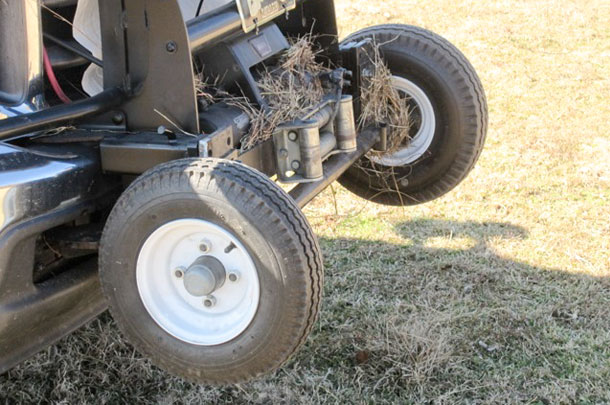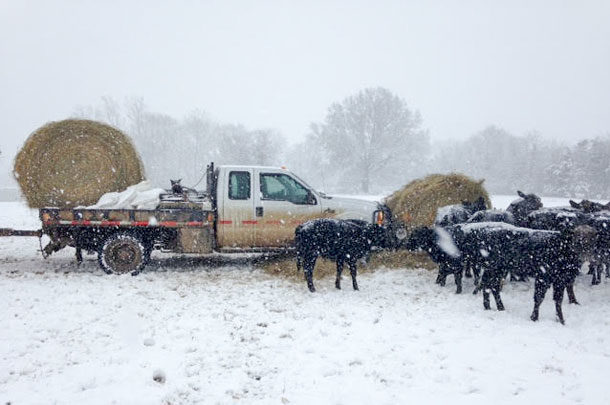He runs a mostly one-man operation, feeding roughly 400 head of Angus cattle over 1,500 acres in the northern Mississippi hills. Anderson says it is always a rush to get the cattle fed.
“Down here we get a lot of rain,” he says. “It’s pretty hard to get a bale without getting rain on it, so you get in a big hurry.”
Anderson says the process of using his creation with round bales is quick and simple.
“Coming out of the barn, we remove the strings and then we just push them with the truck. As you drive along, the wheels turn and they just line up about bumper height on the front of the truck, about even with the bumper, but they don’t stick out very much. I reckon the wheels are about 8 inches in diameter and maybe 4 inches wide. They’re inflatable – you’ll want inflatable wheels with them – and they roll backwards. We push them and you unroll the bale down to just a couple of feet, and then you can finish that easy with your hands.”
Anderson used old salvage equipment that was lying around to make his bale unroller.
“We just used junk that we had,” he says. “We had some old boat trailer axles. The boats don’t last very long, or they get wrecked or sink, but they still have the trailers, and when you get another one, they just give you another trailer to haul it off.”
Anderson took the extra trailer axle that he had and attached it to the front of his truck, on the heavy metal grill guard. Using more spare parts, like the tow bar from a receiving hitch, he attached the receiving hitch to the truck by welding pieces of metal tubing to the bumper.
“There’s a piece of tubing on each side welded to the axle; you just plug that in and mount it in a minute,” Anderson says.

He says the size and weight of the unroller (even the wheels on the axle) do not throw off the balance or stick out inconveniently far from the front of the pickup.
“You can just leave it on there; it doesn’t stick out that much,” Anderson says. “It doesn’t stick out any more than a winch, and not as much as a snow plow.”
Anderson says using his unroller makes his hay go twice as far. The unroller works with any size or density of bale, and it’s easy to roll the bale in any direction.
“You can just use one wheel, right or left, or you can use both wheels,” he says. “You can turn the bales left or right. With some practice, you can make them go wherever you want to.”
Anderson says the unroller works well on rough terrain. “Over here in the hills, we have eroded places,” he says. “We take bales in gullies and such; it’s useful for that. It spreads your hay and your manure around the whole pasture. It’s good plant food; I think it’s very good for the environment.”
Anderson has had almost 20 years to perfect his creation and has proven its usefulness.
“I had my first one back in 1997,” Anderson says. “We used to roll them with our hands, but I’m 60 years old now and not as good a roller as I used to be.”
Anderson says his unroller has helped enable him to keep running things on his own, but a 60-year-old farmer with 400 head of cattle to feed every day needs all the help he can get in the wintertime. “I used to have more help, but it’s hard to find more help now on the farm, but one man can do the feeding now,” he says. “It takes the place of one hired hand.”
Anderson says he uses four of his unrollers on his ranch. Two are mounted on tractors and two are mounted on flatbed trucks. “We can put a bale on the back of a truck, or we can pull a trailer with three bales and get out four at once, and we go from pasture to pasture feeding them,” he says. “I think it’s pretty efficient; they don’t waste any of the hay, and you can hardly tell where you fed them.”
Anderson prefers using round bales over square bales because it gives calves and weaker cows an equal chance at the hay and makes it easy to measure out how much they need for the day. He only feeds his cattle as much as they really need, so they can clean it all up in one day and not waste any hay.
One foreseeable problem with a roller on the front of a truck is accidentally driving on the hay and making a mess, but Anderson says a little concentration and practice makes everything go smoothly. “We straddle the hay and it’s no problem at all,” he says. “The swath of hay is only 4 or 5 inches high and 5 foot wide. It’s like a snowball in reverse.”
In Anderson’s opinion, it would be a simple affair for anyone to make a bale unroller from scratch. “You can buy a small axle like that at a farm store for maybe $100,” he says. “If you bought all new stuff, you could probably do it for a couple hundred dollars.” FG
Carrie Veselka is an English major at Brigham Young University – Idaho.
PHOTO 1: One bale unroller makes it possible for Andy Anderson, a 60-year-old rancher, to feed 400 cows by himself.
PHOTO 2: This homemade bale unroller mounts to the front of a pickup using an old boat trailer axle. Photos by Andy Anderson.











